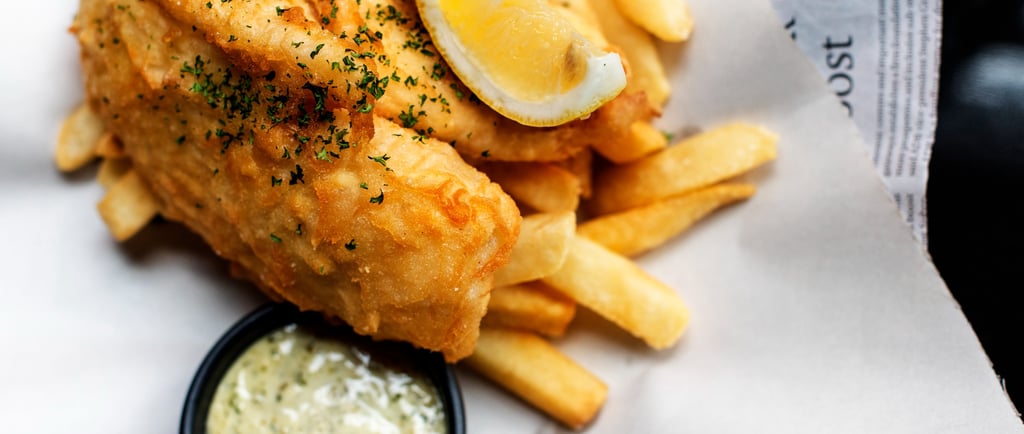Lisez les articles ci-dessous pour apprendre un peu de la culture
Bienvenue sur mon blog consacré à la culture anglaise ! Que vous soyez curieux de découvrir des plats traditionnels comme le fish and chips, que vous souhaitiez explorer la beauté de la campagne britannique ou en apprendre davantage sur les monuments emblématiques, vous êtes au bon endroit. Je vous emmène à la découverte des habitudes quotidiennes, des faits étonnants et de tout ce qui rend l’Angleterre si unique. Prêt à plonger dans cet univers ? C’est parti !
Catherine Rompais
5/8/20245 min read


🇫🇷Connaissez-vous l’histoire du fish and chips ?
Le fish and chips, un plat emblématique de la cuisine britannique, est profondément ancré dans l’histoire, remontant au XIXe siècle. Cette combinaison de poisson frit et de pommes de terre frites croustillantes est devenue un symbole de la culture britannique, avec des racines liées à la Révolution industrielle et à l’immigration.
Les origines du fish and chips sont doubles, chaque composant du plat venant de traditions culturelles différentes. Le poisson frit, tel que nous le connaissons, a été introduit en Grande-Bretagne par des immigrants juifs d’Espagne et du Portugal au XVIe siècle. Ces Juifs séfarades préparaient le poisson en le faisant frire dans l’huile, une technique appelée pescado frito. Cette méthode, qui consistait à frire le poisson dans une pâte, permettait de le conserver avant l’arrivée de la réfrigération, ce qui en faisait un plat pratique et populaire parmi les classes ouvrières. Le poisson était facilement disponible au Royaume-Uni grâce à la proximité de la mer et au développement de l’industrie de la pêche.
L’autre partie du plat, les chips (ou frites), viendrait de France ou de Belgique, où elles étaient couramment servies en accompagnement des repas. La première mention de pommes de terre frites servies en Grande-Bretagne remonte aux années 1800, lorsque des marchands ambulants dans le nord de l’Angleterre commencèrent à en vendre comme collation bon marché.
L’union du poisson et des frites en un seul plat est généralement attribuée à la Révolution industrielle. Avec la montée des usines mécanisées et l’urbanisation au milieu du XIXe siècle, les ouvriers avaient besoin de repas abordables, nutritifs, faciles à préparer et à emporter. Le fish and chips répondait parfaitement à ce besoin : un plat chaud, consistant, et rapide à manger. Il devint un symbole de la classe ouvrière, et les fish and chip shops commencèrent à fleurir dans les villes industrielles.
Le premier fish and chip shop au Royaume-Uni aurait été ouvert par Joseph Malin dans l’East End de Londres vers 1860. Malin, un immigrant juif, aurait combiné le poisson frit avec les frites, faisant de son établissement l’un des premiers documentés à servir ce plat aujourd’hui iconique. À la même époque, John Lees de Mossley, près de Manchester, vendait également du fish and chips depuis une cabane en bois sur un marché local, contribuant ainsi à la popularité du plat dans le nord de l’Angleterre.
L’expansion rapide des chemins de fer au XIXe siècle a aussi joué un rôle clé dans la diffusion du fish and chips, permettant d’acheminer rapidement du poisson frais de la mer du Nord vers les villes de l’intérieur. Au début du XXe siècle, on comptait environ 35 000 fish and chip shops à travers la Grande-Bretagne, à leur apogée dans les années 1920.
Pendant les deux guerres mondiales, le fish and chips a gagné encore plus d’importance, devenant un plat réconfortant pour la population britannique. Contrairement à d'autres aliments, il n’était pas rationné, offrant un repas abordable en temps de crise.
Dans le nord de la France, pas moins de sept friteries figuraient parmi les quinze meilleures friteries de France. Cette année, la grande gagnante est Chic Frite, située à Dunkerque (avec pour slogan « nos frites sont fraîches ! »), que nous avons visitée – et on peut vous dire qu’elles sont délicieuses ! https://www.instagram.com/chic.frite/
Aujourd’hui, le fish and chips reste une partie intégrante de la culture culinaire britannique, apprécié par toutes les classes sociales. Bien que le nombre de fish and chip shops ait diminué depuis le milieu du XXe siècle, le plat garde une place spéciale dans le cœur des Britanniques, représentant les racines ouvrières du pays, ses villes côtières et son héritage multiculturel.
Mais cela me fait quand même réfléchir… est-ce un plat anglais ou… français ? 😉 Alors, la prochaine fois que vous pensez au fish and chips… pensez-y à deux fois !
🇬🇧 Did you know the history of fish and chips?
Fish and chips, a beloved British culinary staple, is a dish steeped in history, dating back to the 19th century. The combination of deep-fried fish and crispy fried potatoes has become a symbol of British culture, with its roots intertwined in the Industrial Revolution and immigration.
The origins of fish and chips are two-fold, with each component of the dish coming from different cultural backgrounds. Fried fish, as we know it, was brought to Britain by Jewish immigrants from Spain and Portugal in the 16th century. These Sephardic Jews prepared fish by frying it in oil, a technique referred to as pescado frito. This method of frying fish in batter helped preserve it before refrigeration, making it a practical and popular dish for working-class communities. Fish was widely available in Britain thanks to the proximity to the sea and growing fishing industries.
The other half of the dish, chips, or fried potatoes, is believed to have been introduced to the British Isles from France or Belgium, where they were commonly eaten as an accompaniment to meals. The first record of fried potatoes being served in Britain comes from the 1800s, when street vendors in the north of England began selling them as an affordable snack. Did you know the
The marriage of fish and chips as a complete meal is generally credited to the Industrial Revolution. With the rise of mechanised factories and urbanisation in the mid-19th century, workers needed affordable, nutritious meals that were easy to prepare and transport. Fish and chips met this demand perfectly, offering a hot, filling dish that could be eaten quickly. The dish became synonymous with the working class, and fish and chip shops began to appear in large numbers in industrial towns.
The first fish and chip shop in the UK is thought to have been opened by Joseph Malin in London’s East End around 1860. Malin, a Jewish immigrant, is believed to have combined the fried fish with chips, making his shop one of the earliest documented establishments serving this now-iconic dish. Around the same time, John Lees of Mossley, near Manchester, was also selling fish and chips from a wooden hut at a local market, contributing to the dish’s rise in the north of England.
The rapid growth of the railways in the 19th century further contributed to the popularity of fish and chips, as fresh fish from the North Sea could be transported quickly to inland towns and cities. By the early 20th century, fish and chip shops were a common sight across Britain, numbering around 35,000 at their peak in the 1920s.
During both World Wars, fish and chips became even more significant as a morale booster for the British people. Unlike many other foods, they were not rationed during the wars, providing a comforting and affordable meal during times of hardship.
In the north of France claimed a staggering seven chip shops in the top 15 best chippies in France. This year’s overall winner was Dunkirk-based Chic Frite (whose slogan is “nos frites sont fraiches!”) which we have visited last year on the day they won the best chips competition, and we can say they're delicious! https://www.instagram.com/chic.frite/
Today, fish and chips remains an integral part of British food culture, enjoyed by people of all classes. While the number of fish and chip shops has decreased since the mid-20th century, the dish continues to hold a special place in the hearts of the British, symbolising the country’s working-class roots, its seaside towns, and its multicultural heritage.
It does make me wonder though, if it's an English or a French thing...... So when you think of fish and chips, think again!



